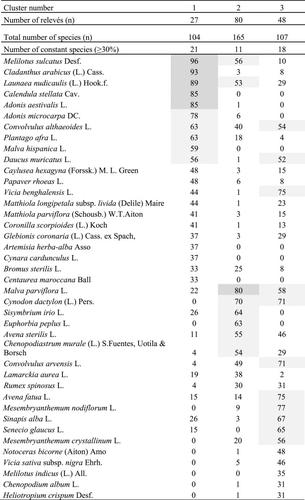Our official English website, www.x-mol.net, welcomes your feedback! (Note: you will need to create a separate account there.)
Arid agroecosystem plant diversity results from habitat-specific traditional management
Flora ( IF 1.9 ) Pub Date : 2024-03-02 , DOI: 10.1016/j.flora.2024.152475 Soufian Chakkour , Erwin Bergmeier , Stefan Meyer , Mhammad Houssni , Khalil Kadaoui , Abdelouahab Sahli , Jalal Kassout , Mohammed Ater
Flora ( IF 1.9 ) Pub Date : 2024-03-02 , DOI: 10.1016/j.flora.2024.152475 Soufian Chakkour , Erwin Bergmeier , Stefan Meyer , Mhammad Houssni , Khalil Kadaoui , Abdelouahab Sahli , Jalal Kassout , Mohammed Ater

|
In the arid landscapes of South Morocco's Saharan fringe, traditional agroecosystems stand out for their rich diversity of segetal vegetation. This study examines the segetal flora of these unique agroecosystems, investigating their richness, community characteristics and composition. We collected 155 relevés in fields located in the Guelmim province comprising three agroecosystem types: Oases, terraced and floodplain fields (faïd). We found 221 vascular plant species including seven regional endemics and one nationally very rare species. Using TWINSPAN, we identified three plant communities, each restricted to a specific agroecosystem type, displaying differences in species composition, floristic status, life-form and biogeographical spectra. Oasis vegetation had the highest overall number of species, terraced fields had the highest diversity, and therophytes were dominant across all communities, with faïds being the most therophyte-rich. The pan-Mediterranean chorotype dominated all three community types. Apophytes dominated, particularly in faïd and terraced fields, surpassing oasis fields rich in ruderals. We found that traditional cereal agroecosystems in southern Morocco harbor species-rich segetal plant communities created by habitat-based land-use systems. Our results highlight the significance of agricultural practices and local abiotic factors in shaping the agroecosystems, which are adapted to arid environments and sensitive to environmental and social changes.
中文翻译:

干旱农业生态系统植物多样性源于特定栖息地的传统管理
在摩洛哥南部撒哈拉沙漠边缘的干旱地区,传统的农业生态系统因其丰富的植被多样性而脱颖而出。本研究考察了这些独特农业生态系统的植物区系,调查其丰富度、群落特征和组成。我们在盖勒敏省的田地中收集了 155 个相关数据,包括三种农业生态系统类型:绿洲、梯田和洪泛区 (faïd)。我们发现了 221 种维管植物,其中包括 7 种地区特有植物和 1 种全国非常稀有的植物。使用 TWINSPAN,我们确定了三个植物群落,每个群落仅限于特定的农业生态系统类型,显示出物种组成、植物区系状况、生命形式和生物地理谱的差异。绿洲植被的物种总数最高,梯田的多样性最高,所有群落中的食生植物均占主导地位,其中法伊兹的食生植物最为丰富。泛地中海脉型在所有三种群落类型中占主导地位。土生植物占主导地位,特别是在法伊德田和梯田中,超过了富含粗土植物的绿洲田。我们发现摩洛哥南部的传统谷物农业生态系统拥有由基于栖息地的土地利用系统创建的物种丰富的植物群落。我们的研究结果强调了农业实践和当地非生物因素在塑造农业生态系统方面的重要性,农业生态系统适应干旱环境并对环境和社会变化敏感。
更新日期:2024-03-02
中文翻译:

干旱农业生态系统植物多样性源于特定栖息地的传统管理
在摩洛哥南部撒哈拉沙漠边缘的干旱地区,传统的农业生态系统因其丰富的植被多样性而脱颖而出。本研究考察了这些独特农业生态系统的植物区系,调查其丰富度、群落特征和组成。我们在盖勒敏省的田地中收集了 155 个相关数据,包括三种农业生态系统类型:绿洲、梯田和洪泛区 (faïd)。我们发现了 221 种维管植物,其中包括 7 种地区特有植物和 1 种全国非常稀有的植物。使用 TWINSPAN,我们确定了三个植物群落,每个群落仅限于特定的农业生态系统类型,显示出物种组成、植物区系状况、生命形式和生物地理谱的差异。绿洲植被的物种总数最高,梯田的多样性最高,所有群落中的食生植物均占主导地位,其中法伊兹的食生植物最为丰富。泛地中海脉型在所有三种群落类型中占主导地位。土生植物占主导地位,特别是在法伊德田和梯田中,超过了富含粗土植物的绿洲田。我们发现摩洛哥南部的传统谷物农业生态系统拥有由基于栖息地的土地利用系统创建的物种丰富的植物群落。我们的研究结果强调了农业实践和当地非生物因素在塑造农业生态系统方面的重要性,农业生态系统适应干旱环境并对环境和社会变化敏感。



























 京公网安备 11010802027423号
京公网安备 11010802027423号